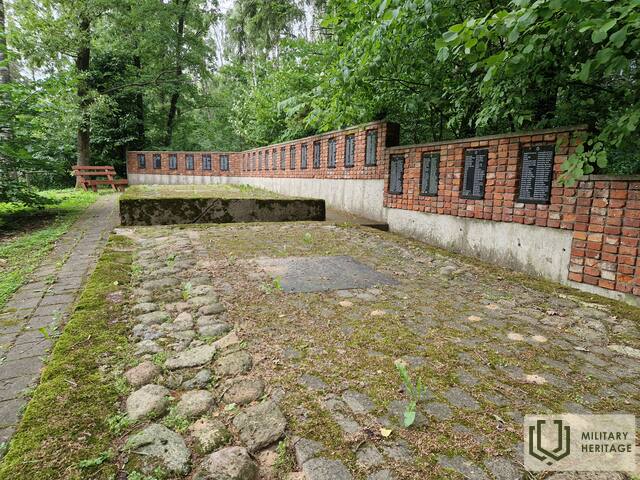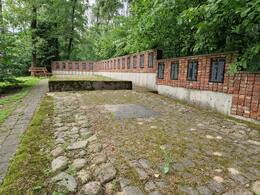The fate of the Jews of Plungė
In the summer of 1941, almost the entire local Jewish community of more than 1,800 people was brutally destroyed in Plungė. People were imprisoned in terrible conditions, starved to death, and finally shot in the Kaušėnai forest. The mass murders were carried out by local collaborators.
On June 22, 1941, after the German army entered the Soviet Union, Jews began to flee from Plungė to the surrounding villages, but only 30 families managed to escape. The train traveling from Plungė was attacked by German soldiers, and all its passengers were killed. Among them were dozens of Jewish families.
The Germans reached Plungė on June 25, 1941. On the second day of their arrival, the Jews were ordered to leave their homes and gather in the synagogue. Armed guards stood near the doors, preventing the imprisoned Jews from receiving food brought by their former Lithuanian employers and friends. The situation in the synagogue, where the Jews were imprisoned, was terrible: dirt, stench, and hunger.
On July 13, 1941, the Jews began to be driven to the places where the pits had already been prepared. The first group consisted of 60 men who were walking. About 40 of them were killed along the way, the rest of the victims were driven to the murder site. There they were forced to undress and sit on the edge of the pits, where they were shot from behind. Groups of girls were also led to the murder site. When they passed the Plungė church, a student, Urla Zin, said a few angry words about Lithuanians. The murderers poured kerosene on her and burned her alive. Among the murdered were a group of 60 high school girls who agreed to be baptized and become Catholics in order to save themselves. However, all of them were also killed and buried in a common grave, near the pits of their murdered families in Kaušėnai. The murders took place from Sunday morning all night until the next day. In the morning, the killers got into trucks and returned to the city singing. The two Germans who were in the city did not participate in these massacres. All the "work" was done by local Nazi aides, most of whom were residents of the city and the surrounding area.
Only one Jew and his children were saved from death, because before the war he had converted to Christianity and married a Lithuanian woman. His wife was free, she begged Canon Povilas Pukis to save her family. With the help of P. Pukis, her husband and children were released from the synagogue. When the Soviets returned to Plungė, he revealed the names of the murderers to the authorities and helped them search for the criminals.
Of all the Jews of Plungė, only 221 survived the war. These were those who hid with Lithuanians, those who were in the Šiauliai ghetto, and those who retreated deep into the Soviet Union. After the Germans were driven out of Lithuania, about 30 Jewish families returned to their homes, which they found ransacked.
Related timeline
Related objects
Kaušėnai Holocaust Memorial
In the village of Kaušėnai (Plungė district), a memorial to the victims of the Kaušėnai Holocaust has been established at the site of the murder of the Jews. The memorial is dedicated to the Jewish communities of Plungė and the surrounding villages that were destroyed during World War II.
The memorial was established based on the initiative of the last Jew of Plungė, Jakovas Bunka. The first monument to the victims of the Second World War was erected in 1952, and in 1986–1989, a memorial to commemorate the murdered Jews was created from oak monuments. 1,800 bricks of the demolished Plungė Synagogue were used to build the Memorial Wall in 2011, where each brick is dedicated to the memory of someone murdered,
and plaques with the known names of 1,200 (out of 1,800) Jews are affixed to the wall. The Alleyway of the Rescuers is located near the memorial, and the names of those who rescued the condemned Jews in Plungė and its surroundings during the Nazi occupation are inscribed on the posts in the alleyway.
On 12 and 13 July 1941, about 1,800 Jews from the Plungė district were murdered on Kaušėnai Hill, having been held for two weeks in brutal conditions in the Plungė synagogue before that. On the day of the genocide, those who could were made to walk five kilometres to the place of execution, while the rest were transported in separate groups by lorry. The victims were ordered to dig their own graves and then they were shot.
The memorial is one of the ten most impressive memorials in Europe reflecting the tragedy of the Jewish people.
Litvak Memorial Garden
In 2014, the Jacob Bunka Charity and Support Foundation established the Litvak (Lithuanian Jew) Memorial Garden in Žemaitija National Park, approximately two kilometres from the centre of Plateliai, in the village of Medsėdžiai. It is a monument dedicated to the eliminated Jewish communities of Lithuania. The garden reproduces the contours of Lithuania, while the sites where Jewish communities were eliminated in 1941–1944 are marked with wrought-iron apple trees. The author of the carved apple trees is Artūras Platakis. The apples in the trees signify families that have lived in these communities. Litvaks from around the globe can participate in the development of the garden by ordering new apple trees and apples in memory of their ancestors. The garden also features pillars made of Karelian granite that individually celebrate the achievements of Litvaks worldwide.
In 2016, the initiative was extended to include the Litvaks, who lived throughout the territory of the Grand Duchy of Lithuania, and the rescuers of Jews during the Holocaust. A billboard at the entrance to the garden tells the story of former Jewish communities throughout Lithuania.
Currently, apple trees to commemorate the Jewish communities of Alytus, Alsėdžiai, Kalvarija, Mosėdis, Plateliai, Plungė, Telšiai, Vabalninkas, Viekšniai, and others have “grown” at the garden.
Graves of Holocaust victims in Šateikiai
The site and grave of the massacre of women and children of the Salantai Jewish community is a historical cemetery of Holocaust victims in the northwestern part of the territory of the Plungė district municipality, in Šateikiai Rūdaičiai (Plateliai eldership), 0.5 km northeast of the Skuodas-Klaipėda road, on the northwestern edge of the Šateikiai forest.
The gravesite is rectangular in plan, 10 x 10 m in size, surrounded by a wire mesh fence. In its northwestern part, there are metal, openwork, single-leaf gates, the upper part of which depicts the Star of David. The Star of David and a memorial inscription in Yiddish and Lithuanian are carved on the monumental granite slab. In 1980, a wooden sculpture depicting a standing Jew with his hands tied was erected (author - folk artist Jakovas Bunka). The area of the territory is 0.01 ha.
In this place, in July–August 1941, auxiliary policemen from Salantai and Šateikiai killed women and children of the Salantai Jewish community. The execution took place in three stages. The first massacre took place around July 20, 1941. On the orders of the police, carters with carts arrived from the villages at dawn near the Salantai synagogue, where Jewish women and children were being held, and, accompanied by auxiliary policemen, took about 60–70 women to Šateikiai Forest. During the second massacre, at the end of July, the last remaining women and children in the ghetto were killed, more than 50 of them. At the end of August, auxiliary policemen escorted about 100 Jewish women from Salantai to Šateikiai Forest for execution. Since July, they had been working as auxiliary agricultural workers at the Šalynas Manor and with farmers in the Salantai Rural Municipality.
According to the Holocaust Atlas in Lithuania, 95 victims are buried here. The memorial plaque at the gravesite and the document collection "Mass Massacres in Lithuania" indicate that 100 Jewish men, women and children were killed here. Paulius Vaniuchinas, a researcher of the history of Salantai, determined that 210–220 women and children were killed at this site.
The site of the massacre and burial was declared a historical monument of local importance in 1970 and registered in the register of cultural heritage in 1993.
Plateliai Jewish massacre site and graves (Jazminai Hill)
A hill called Jazminų kalnas, located on the outskirts of the town of Plateliai. At the foot of the hill in July 1941, 30 Jews from Plateliai were shot (some of the Jews from Plateliai were shot on the Laumalenkai Peninsula). During the interwar period, about 100 Jews lived in Plateliai, but “[…] the fate of all was the same. At first, as was customary, they gathered the men, right here near Plateliai, you see, where the monument stands – they shot them there. A couple of weeks later, they took the women, children, and the elderly here, outside Plateliai, a few kilometers away into the forest, and shot everyone there,” said Eugenijus Bunka, the son of Holocaust survivor folk artist Jakovas Bunka.
Around 1985, his father, folk artist Jakovas Bunka, carved and erected a decorative sculpture of Moses on the mountain. In 2016, the sculpture collapsed, and in 2018, a copy, carved by folk artist Antanas Vaškis, was erected.
At the foot of the mountain, a monumental granite slab was also erected in memory of the Jewish genocide, with inscriptions in Yiddish and Lithuanian: "The blood of 30 Jews – children, women, men – was shed here. They were brutally murdered by nationalists and their local collaborators in July 1941. May the memory of the innocent victims be sacred." In 2019, two more granite slabs were added with a list of Jews living in Plateliai in 1939.









